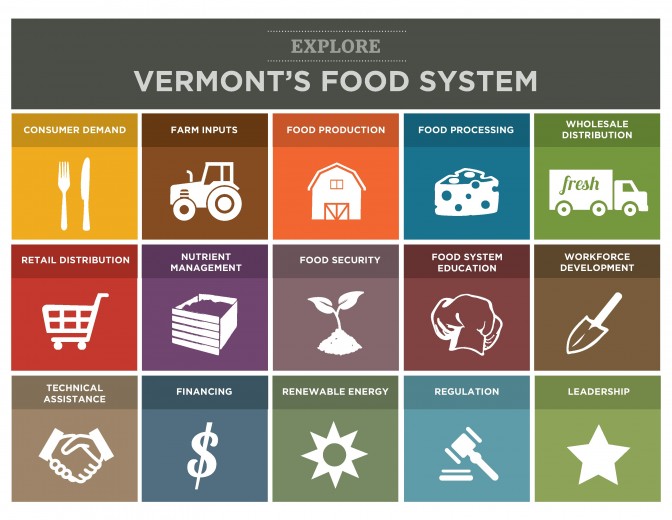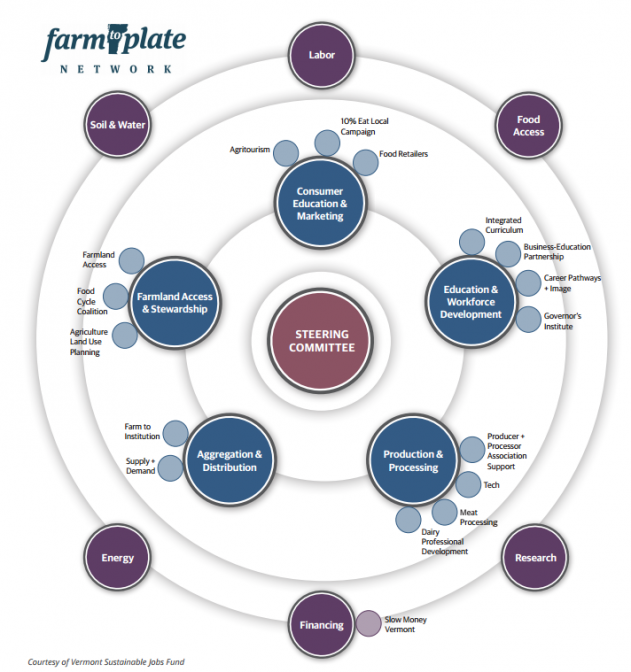Vermont Farm to Plate Plan Highlights
Dr Nick Rose, Executive Director, Sustain
The Vermont Farm to Plate Plan is widely regarded as the most comprehensive food system program in the United States, and the only one with full government engagement. It’s approaching the end of its first decade, and gearing up for the next with a growing global reputation. The Plan takes a coordinated, long-term and collaborative approach with all parts of the food system, far beyond a simple focus on agricultural output.
What’s possible – Vermont Farm to Plate Plan Highlights
Established through state legislation, the Vermont Sustainable Jobs Fund’s Farm to Plate program provides clear evidence of the value of a whole of system approach.
Since 2010 Vermont’s Farm to Plate Plan has:
- Increased purchases of local food increase from $176 million to $310 million
- Supported the creation of 6529 net new jobs in food-related industries
- Helped the establishment of 379 net new food and farm businesses
- Achieved a 26% reduction in the number of food insecure people across the state
We’re not just doing this from a dollars and cents perspective. We’re doing this because it gives meaning to people’s lives. And it’s a critical connection into our past, and also a really important road into our future
The goals of the Festival and speaking tour are to:
- Galvanise the WA and national food movement leadership around high impact actions
- Foster food system stakeholder cooperation, information and best practice exchange, and enhance confidence in actors’ capacity to effect significant changes
- Showcase a world-leading approach in establishing whole-of-system policy and practice framework, with an emphasis on lessons learned from both successes and failures
- Identify the types of partnerships, skills, experience and capacity, infrastructure, governance options, funding requirements and financing options that are necessary in order to develop and implement a regional and / or state-level food and farming strategy
Participants will for the first time be able to hear directly from Jake Claro, who has been Director of the Vermont Farm to Plate Plan since 2012. Mr Claro’s presentations will address matters of direct relevance and importance to policy-makers and stakeholders working at the local and state government levels in Australia including:
- Viability challenges for regenerative farmers / farmers delivering social/environmental goods and the public investment argument to support them
- The realities / challenges / key success factors for food distribution enterprises
- How to combine economic development goals with enhancing good food access and tackling food insecurity
- What have been the critical success factors for the major successes achieved in the first 10 years of the Farm to Plate Plan
- Policy frameworks and funding requirements to implement the Farm to Plate Plan
- Governance, engagement and the role of Collective Impact methodology
About Jake Claro, Vermont Sustainable Jobs Fund

As the Farm to Plate Director at the Vermont Sustainable Jobs Fund, Jake is responsible for providing facilitative leadership and strategic coordination to the Farm to Plate Network’s work to implement Vermont’s food system plan. He manages the Farm to Plate team at VSJF and works to align activity among 350 stakeholders and increase collaboration between private sector, non-profits, and government to strengthen Vermont’s farm and food economy for the benefit of all Vermonters. Previously he served as an AmeriCorps member with the Vermont Natural Resources Council (VNRC) and the Vermont Energy & Climate Action Network (VECAN) as a community energy and climate action organizer. At VNRC, Jake worked closely with town energy committees across the state on energy efficiency, renewable energy, and energy planning issues.

Whole of system – Soil to Soil Approach
We take what we call a ‘soil to soil’ approach – looking at the food system from the inputs that go into the land, including the land itself; what happens in terms of production on the land base; how does that food get processed if it does get processed; how does it get distributed, and what are the outlets that it gets distributed to; who are the consumers that are consuming that food, and what are their characteristics; and post-consumption, what happens to that food: how is it recycled? How might it be re-integrated back into a farm input?
So that soil to soil lens is how we developed the plan, and it’s also guided our implementation. We’ve worked with many different organisations, businesses and government agencies that cross many different sectors outside of agriculture
We asked Jake to provide us with an outline of the key achievements and challenges experienced in the first decade of the implementation of the Farm to Plate Plan. What follows is his summary. These are topics that will be explored at length in his speaking schedule.
Farm to Plate Key Achievements
-
Systematically Creating and Implementing A Shared Vision for a Sustainable Food System
Farm to Plate (F2P) has successfully created a comprehensive food system plan and a means to implement the plan. The F2P Plan lives within organizations, is embedded in state strategic decision making e.g., funding/financing, policy, or programmatic decision making, and manifests through the collective action of the F2P Network and its 350+ members. Specific examples include:
-
Creating the Case that Food System Development is Economic Development
Since the passage of the F2P Investment Program in 2009, employment in the farm and food sector has increased by 6,529 net new jobs (an 11% increase), with the number of net new farm and food businesses increasing by 379 (3.3% increase). Additionally, purchases of local food in Vermont increased from $114 million in 2010 to $310 million in 2017. In creating a framework to track food system jobs and establishments, and complementing it with periodic economic impact analysis and local food purchasing figures, F2P has elevated food system development as a key component of Vermont’s overall economic development and outlook, including in more traditional economic development circles – which was far from the case when F2P was passed. -
Increasing Meat Processing Capacity
Through the Meat Processing Task Force, F2P conducted a multi-phase initiative to strengthen meat processing capacity, identified as a bottleneck in the livestock sector. The TF strengthened individual processors operations through targeted businesses assistance, improved supply chain relations by bringing livestock producers together with processors to learn about each other’s needs and processes, and exposed Vermont’s industry to outside expertise, trade shows, and learning journeys to encourage new investment and facility innovation. These efforts led to new facilities and increased investment and capacity at existing facilities, addressing capacity restraints and leading to greater throughput and brand development for Vermont meat products. -
Institutionalizing Local Food Purchasing in Institutions
F2P was instrumental in getting Sodexo, the French multinational food service company and largest food service provider to Vermont colleges and universities, to create a program – Vermont First – with an accompanying local food supply chain management staff position dedicated solely to managing local food procurement for its Vermont accounts. Vermont First purchased $2.8 million in local products last year, and its success led to the creation of a similar program in the state of Maine called The Maine Course. -
Increasing Local Food in Retail and supporting Food Hubs
Through its Independent Grocers Task Force, F2P offers ongoing in-store trainings to independent retailers, along with offering a suite of online worksheets, tip sheets, and training videos. Trainings emphasize the purchasing, promotion, and merchandising of local food to help improve the competitiveness of Vermont independent grocers, which are important assets to rural communities and economies. F2P has also partnered with two regional food hubs to increase their sales exposure in retail locations and increase awareness amongst store buyers of products and services offered through the food hubs. -
Grass-fed Beef Sector Development
With many dairy farms facing financial stress and leaving farming altogether, F2P recognized a strategic need to develop alternative livestock enterprises that could offer a compatible transition for dairy land and infrastructure. F2P has helped the grass-beef industry by analyzing market opportunities and bottlenecks, conducting financial analysis and developing budgeting tools for beef producers, and exposing leaders in the industry to the world renowned Ranching For Profit livestock school. These initiatives have supported the emergence of a viable and integrated grass-fed beef industry in Vermont. -
Comprehensive Municipal and Regional Food System Planning
In partnership with the planning community, F2P has created a series of six food system planning modules that help municipal officials, regional planners, and local advocates advance progressive food system policies and plans in their towns and regions. The latest addition to the modules is a food access planning toolkit that shows how towns and regions can address food access issues through traditional planning topics such as transportation, economic development, land use regulation, and zoning. In addition to these resources, F2P has also worked with stakeholders to normalize statewide regulations related to accessory farm business (farm dinners, on-farm education events, farm stays etc.), and is expanding understanding of these new types of businesses and their importance to the vitality of modern day small scale agriculture. -
Bridging the Food System with Health Care
Through the Health Cross-Cutting Team, F2P is forming stronger formal ties between the healthcare system and the food system. In the past year the Health CCT was successful in submitting strategies on food access to Vermont’s 2019-2023 State Health Improvement Plan (SHIP). The Health CCT will be used as a vehicle to carry out the next steps of implementing the strategies outlined in the SHIP, and inclusion in the SHIP represents an important step in bringing health care resources to the food system.
Farm to Plate Key Challenges
The following are a sample of challenges that, though couched within the context of Vermont, likely have universal characteristics relatable to Australia’s food system that offer potential opportunities for mutual learning, collaborative problem solving, and knowledge exchange.
-
Farm Viability
Though agriculture has experienced what some have considered a renaissance in Vermont over the last two decades, with the greatest number of farms since the 1960s, tightening market conditions pose long-term financial viability challenges across all types of production. As the dairy industry continues to be stressed by low milk prices that are projected to be stagnant for years to come, there’s greater imperative to develop financially viable business models for many relatively nascent industries while keeping more mature non-dairy industries like vegetables, tree fruits, and maple nimble and competitive in dynamic and rapidly evolving local and regional markets. -
Marketing and Distribution
Due to the small scale of the majority of farm and food businesses in Vermont many of these businesses lack dedicated marketing and sales staff to enter into larger markets and maintain a strong sales presence. There’s a chasm between the demand for marketing services and standard industry rates for these services. Additionally, traditional distribution models and consolidation in the distribution industry give producers limited options to access markets and unfavourable terms that are often unsustainable for small scaled businesses. In the next five years F2P will be devoting significant focus to coordinating state branding efforts, brokerage services, cooperative branding and marketing, and strengthening the operations and coverage of regional food hubs to improve the affordability and accessibility of marketing and distribution services to small farm and food businesses. -
Farmland Access and financing operations
With regards to affordably accessing land, beginning and young farmers face very different circumstances than prior farming generations. Land in general has become more expensive. With the dairy industry collectively highly leveraged and becoming less viable, it’s harder to transition those farms as businesses to the next generation, and as a result available dairy land requires additional capital to transition infrastructure and land to other types of production. Add to this a new generation that is often carrying significant levels of student debt, and it becomes challenging to not only initially access land but then cash flow in the first 3-5 years to service mortgage debt in addition to other debt and operating expenses. -
Workforce Development and Wages
Many farm and food businesses report labour shortages as a major constraint on their ability to grow and compete. However, food system wages tend to fall below livable wage standards, and food system employment carries a social stigma as being unskilled and offering limited career growth opportunities. F2P is working to remove the stigma around food system work - expanding students, educators, and workforce development entities’ notions of what types of jobs are available in the food system, while elevating best employment practices and ways in which employers can attract and retain quality employees. -
Climate Change and the Environment
Changing climate conditions pose new management challenges to Vermont farmers in terms of managing more variable and severe weather events, both wet and dry, growing seasons shifting outside of historical norms, and increased pest pressures with warmer average annual temperatures. Additionally, Vermont’s Lake Champlain suffers from excess phosphorus loading, leading to periodic algal blooms that are exacerbated by warmer temperatures. Forty percent of the phosphorus load is attributed to agriculture, and a growing source of tension between farmers and the general public. -
Food Access and Security
Vermont has an active network of charitable food organizations that includes a highly organized foodbank and its partner food shelves, pantries, and meal sites, regional hunger councils working at the local level on food access planning, strong farm to school programming within the school system, and a statewide coalition of gleaning organizations recovering farm surplus for donation to those in need. However, approximately 25,000 Vermont households (9.8%) are food insecure, and the food insecurity rate still tracks in close correlation with overall national macro-economic conditions. How to create access to local foods for these households is a multi-faceted challenge requiring integrated approaches addressing transportation, housing, health-care, and income inequality that don’t traditionally fall within the domain of food system initiatives.